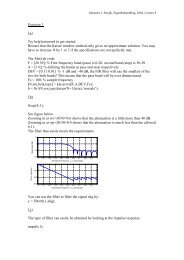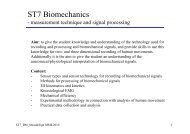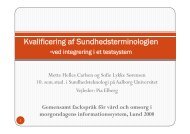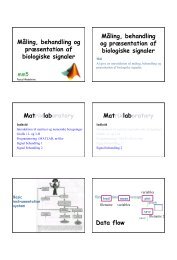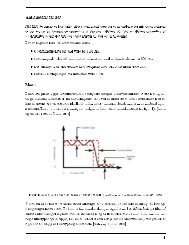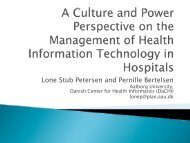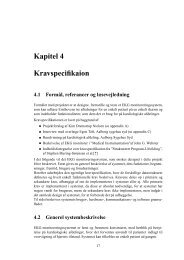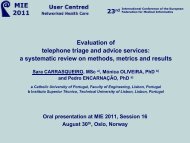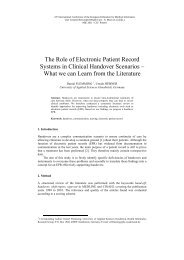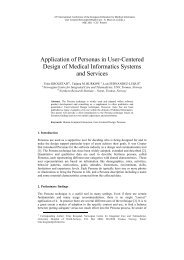Lecture note
Lecture note
Lecture note
Create successful ePaper yourself
Turn your PDF publications into a flip-book with our unique Google optimized e-Paper software.
Keep the systems you already have, and build a smooth connective interface to all the systems through<br />
individual system APIs. When you want to present other things than the individual patient recordings make<br />
quires through the DWH.<br />
What are the preconditions for successful implementation of a new terminology and a master data hub that<br />
will be the glue between all the systems?<br />
- Passionate buiseness sponsership<br />
- History of effective data governance<br />
- Effective choice of tools<br />
Has the SNOMED CT group handled these preconditions?<br />
No "it is up to the vendors". Therefore it will never become a succes!<br />
Classification --> Reference terminology<br />
"From the beginning there has been controversy between those arguing for more formality and knowledge<br />
representation<br />
in medical terminology and those arguing for traditional methods. The claim of one side has always been that<br />
the formal<br />
methods and ontologies were over-complicated and difficult to understand; the claim of the other that it was<br />
the very<br />
need for simplicity for clinicians when working with a computer system which required formal<br />
sophistication – the<br />
‘swans paddle furiously under the water’ argument. The dispute is not yet resolved, but the use of a<br />
description logic as<br />
part of the infrastructure for SNOMED-RT and SNOMED-CT suggests a move in the direction of formality.<br />
Work on practical terminologies has also brought with it the need to confront version and change<br />
management more<br />
usually addressed in the database community. Change was central to Campbell’s proposals for the<br />
Convergent Terms<br />
Project which eventually became SNOMED-RT[20]. Change management has been explored in more general<br />
terms<br />
both by Cimino and his colleagues [26] and more recently by Oliver [87]. Full integration of change<br />
management and<br />
formal techniques remains one of the major challenges facing practical use of formal ontologies.<br />
In the meantime, the central role of medical terminology in medical records now seems to be becoming<br />
established ,<br />
and the aspirations act as the glue amongst applications are beginning to be realised [108]"- rectors<br />
homepage http://www.cs.man.ac.uk/~rector/home_page_rector/aim-bio-paper-rector.pdf<br />
What are the fundamental problem dealing with classifications and terminology<br />
- Information about entities is entered in multiple systems and there will be different interpretations<br />
about the entities<br />
○ What is a diagnosis (patient etc.)?<br />
○ We need a 360 view of a diagnosis, patient etc.<br />
○ How do we handle changes over time<br />
When using the is_A (parent-child) relationships from the SnoMedCT system it will be possible to create<br />
deeper classification hierarchies from the exsisting claissification systems.<br />
How does the reference terminology fit in here?<br />
- Most systems are already ready for references build into them. Use these mechanisms that are already<br />
described and managed in paper (http://www.sst.dk/~/media/Indberetning%20og%<br />
20statistik/Patientregistrering/Faellesindhold%202011.ashx ) It is not in English --sorry<br />
Eks. Patient Administration System - additional codes<br />
AAU side 6



